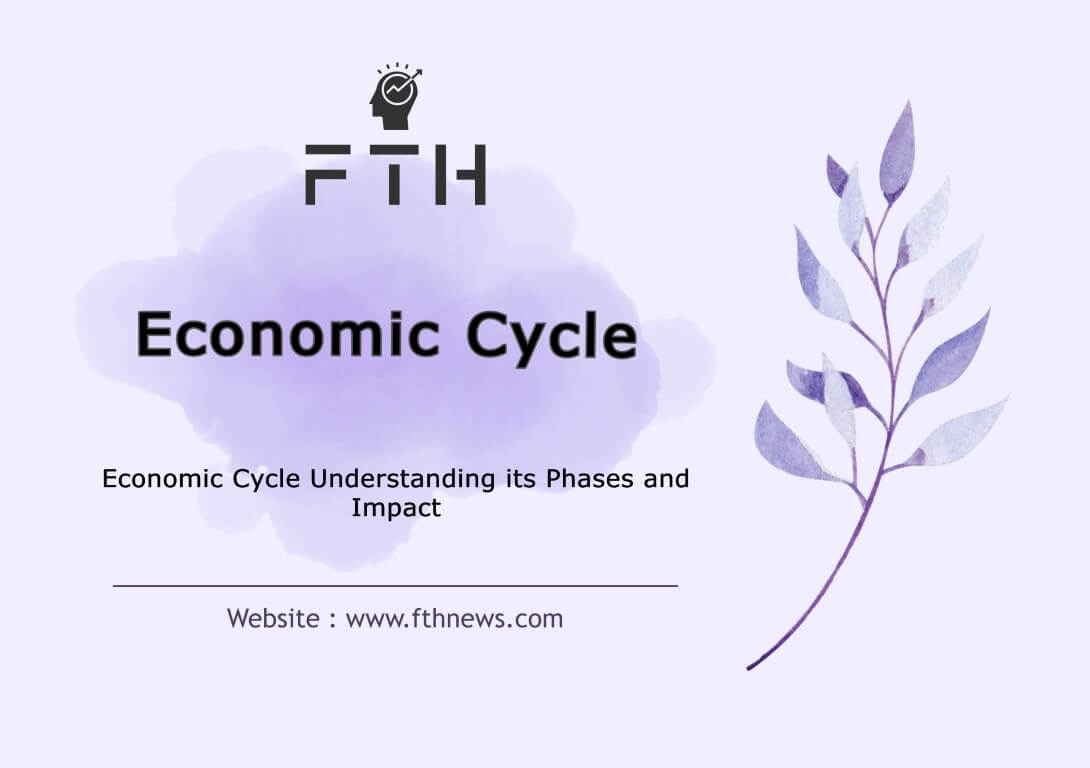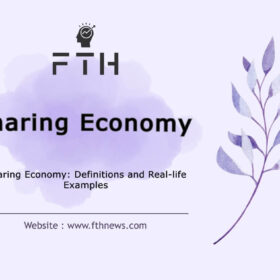
Economic Cycle: Understanding its Phases and Impact
The economic cycle, often referred to as the business cycle, is a fundamental concept that revolves around the fluctuations in the Gross Domestic Product (GDP) index.
These fluctuations occur around its natural and long-term growth process, revealing distinct stages of expansion and contraction within the economy. While the economic cycle holds particular significance for traders and investors, its impact extends to everyone.
The Stages of the Economic Cycle
Understanding economic cycles is vital, as it influences the behaviors of investors, traders, and individuals alike.
1. Expansion Phase (Economic Growth)
In the initial phase of the economic cycle, we witness an upsurge in economic activities. Key economic indicators, such as employment, income, production, wages, company profits, and the demand and supply of goods and services, experience robust growth. During this phase, debtors are able to meet their financial obligations, financing conditions are favorable, and investments proliferate.
2. Peak Period of Economic Growth
The peak period of economic growth marks the second stage of the economic cycle. During this phase, economic growth reaches its zenith and can no longer expand. Economic indicators stagnate, signaling a need for a shift in the economic growth process. This transition signifies a forthcoming period of economic contraction, as the GDP growth rate aims to return to its long-term average.
3. Contraction Phase (Recession)
In this stage, economic growth descends from its peak, and the demand for goods and services rapidly declines. Producers often overlook the dwindling demand and continue production, leading to an oversupply of goods and a subsequent fall in prices. Crucial economic indicators such as employment, income, and wages begin to decline, and the economic growth rate or GDP descends towards zero percent.
4. Depression Period
During an economic recession, the unemployment rate significantly rises, and the GDP continues to shrink, crossing below the average line. This implies a gradual reduction in the GDP size. Financing becomes scarce, and consumer spending wanes. Even discounts and special offers struggle to boost the sale of goods and services. Finding employment becomes challenging, and investments become scarce.
5. Trough Period of Economic Growth
In the depths of an economic recession, the economic growth rate turns negative, indicating a contraction in the GDP’s size. After some time, the economy reaches a point where it can’t decline further. The economic growth rate stabilizes and is poised to return to a more neutral level. Typically, government financial and monetary expansion policies come into play, preventing further GDP decline.
6. Recovery Stage of Economic Growth
Following the bottoming out of the GDP, economic activities gradually gain momentum. This stage sees a reversal in the trend of economic indicators, as conditions improve. The GDP growth rate strives to move from negative to positive territory. Supply and demand begin to rise gradually, accompanied by growth in investment and employment. Financing conditions in the economy also improve. This economic recovery continues until the GDP growth rate reaches its neutral position, paving the way for the boom or expansion phase of economic growth.
Exploring the Causes of Economic Cycle
Before delving into the reasons behind the occurrence of economic cycles, it’s essential to understand that these cycles are not exclusive to certain societies or countries. Instead, they are a natural process that accompanies the ever-evolving conditions of society. To grasp this concept more clearly, consider a few examples:
Political Transitions:
In many countries, presidential terms last for four years. As a new leader takes office, changes in financial policies, international relations, and more may ensue. These transitional periods often set the stage for the initiation of a new economic cycle.
Impact of Conflicts:
When a nation experiences a war, the inevitability of an economic cycle becomes apparent. The effects of such events should be analyzed over the long term, as they can have a lasting impact on economic conditions.
Positive Developments:
Positive events such as advancements in education, technological progress, and other societal improvements take time to manifest in businesses. Once these effects become palpable, they often mark the inception of a new economic cycle.
Based on the above explanations, we can categorize the reasons for the occurrence of economic cycles into several distinct parts:
Predetermined Political Events:
These events, such as changes in leadership (e.g., presidential transitions), can induce shifts in a society’s domestic and international economic landscape.
Decisions by Key Authorities:
Decisions made by authoritative bodies, such as central banks adjusting interest rates or stock exchange organizations altering trading parameters, can influence people’s financial behavior. Significant changes in these decisions can set the initial stages of an economic cycle in motion.
Protracted Conflicts:
civil wars or international wars can lead to long-term economic cycles. These conflicts deal severe blows to the economy, foster the creation of black markets, and necessitate lengthy recovery periods.
Social Dynamics Over Time:
Even in optimal social, economic, and educational conditions, the passage of time can give rise to economic cycles. Generational shifts in intellectual perspectives and evolving societal norms can shape the long-term trajectory of these cycles.
Understanding the multifaceted nature of economic cycles and the diverse factors contributing to their occurrence is crucial for a comprehensive grasp of their impact on societies and economies.
Key Components of the Business Cycle
Extensive research and studies have delved into the business cycle, its causes, and its essential components. While the complexity of economic dynamics offers a multitude of contributing factors, experts predominantly identify two main components at the core of the business cycle: “Interest Rates and Financial Markets” and “Gross Domestic Product (GDP).” Let’s explore these components in greater detail.
1. Interest Rates and Financial Markets
The ebb and flow of interest rates and the vitality of financial markets are integral components of the business cycle. As interest rates fluctuate and financial markets exhibit distinct trends, they significantly impact the trajectory of the business cycle. When the stock market experiences an upswing, businesses often thrive. If this trend continues, it can signify the initiation of a new business cycle, characterized by expansion and growth.
2. Gross Domestic Product (GDP)
Another paramount component of the business cycle is the Gross Domestic Product (GDP). This metric serves as a crucial barometer of a nation’s economic health. The fluctuations in GDP exert a profound influence on the overall economic prosperity or recession of a country. As the GDP undergoes variations, it shapes the various stages of the business cycle, reflecting periods of growth, stagnation, or contraction.
It’s important to note that while interest rates, financial markets, and GDP stand as primary components of the business cycle, the dynamics of each country’s economic cycle can be influenced by unique native factors. These idiosyncratic elements may encompass specific industries, government policies, international trade, and more. Understanding the interplay of these components is vital for comprehending the intricacies of the business cycle within a given context.
Models for Analyzing the Economic Cycle
It’s important to acknowledge that any model designed by economists for business cycle analysis is subject to continuous refinements, adjustments, and adaptations over time. The criteria, components, and even local factors evolve, and this evolution should be considered when assessing the business cycle. That said, two conventional business cycle analysis models have been widely recognized: the “AS-AD” model and the “ADI” model.
1. AS-AD Model (Aggregate Supply and Aggregate Demand)
The AS-AD model, often referred to as the traditional business cycle analysis model, is constructed on the foundational concept of equilibrium between aggregate supply and aggregate demand. Total demand in this model encompasses “consumer demand of households,” “investment demand of enterprises,” “government demand,” and “net exports (NX).” On the other hand, total supply is a more intricate aspect, as it factors in variables such as technology levels, productivity, real wages, and salaries, which exhibit considerable variations over different time frames.
2. ADI Model (Aggregate Demand and Inflation)
The ADI model is a refinement that extends the principles of the AS-AD model. In this model, the primary focus remains on the interplay between supply and demand, but it introduces a role for the central bank in managing the business cycle. The central bank can adjust interest rates in response to the prevailing inflation levels. For instance, if inflation is on the rise, the central bank may opt to increase interest rates. This move, in turn, can lead to a reduction in investment demand in the economy, ultimately helping to control inflation to some extent.
It’s crucial to emphasize that the study of the business cycle is a specialized field within macroeconomics, with models and calculations typically handled by economic experts. However, even for those not well-versed in the intricacies of these models, a basic understanding of the business cycle concept can prove invaluable in comprehending the current economic conditions and developments.
Navigating Business Cycles: Strategic Insights for Enterprises
Businesses can greatly benefit from considering the interplay between their performance and the economic cycle over time. By understanding how the business cycle operates, companies can develop strategies to safeguard their operations during market downturns and position themselves to capitalize on opportunities during economic upswings.
1. Adapting to the Economic Cycle:
A key consideration for businesses is aligning their strategies with the economic cycle. When your business cycle mirrors the broader economic cycle, being attuned to warning signs of an impending economic downturn can be invaluable. Rather than expanding your business during uncertain times, it might be wiser to invest resources in shoring up your financial position. This might involve creating a cash reserve to weather the challenges that lie ahead.
2. Preparing for Market Volatility:
Economic cycles entail both periods of growth and contraction. Businesses should anticipate these fluctuations and develop adaptable business plans. During economic expansions, seize the opportunity to invest in research and development, expand your customer base, and consider strategic partnerships. On the other hand, during downturns, focus on cost-cutting, efficient resource allocation, and preserving liquidity.
3. Risk Mitigation:
Understanding the business cycle allows companies to identify potential risks early on. For instance, if your business heavily relies on consumer spending and the economic indicators hint at reduced consumer confidence, consider diversifying your revenue streams or adopting a more conservative financial stance. Businesses can also explore risk management tools, such as hedging strategies, to protect against adverse economic conditions.
4. Customer-Centric Approach:
During economic downturns, maintaining a customer-centric approach becomes paramount. Businesses that prioritize customer relationships and adapt their offerings to address customer needs during tough times are more likely to retain customer loyalty and market share. This customer-focused strategy can help sustain your business during economic challenges.
5. Strategic Investments:
In times of economic recovery, consider making strategic investments that align with your long-term goals. This may include expanding your product line, entering new markets, or upgrading technology infrastructure. The economic upswing can provide a favorable backdrop for growth-oriented endeavors.
6. Continuous Monitoring:
Stay vigilant in monitoring economic indicators, as they offer valuable insights into the state of the economy. Regularly reassess your business strategies in light of changing economic conditions and make necessary adjustments to stay agile and resilient.
Incorporating these principles into your business approach can help you navigate the economic cycle more effectively. By understanding the dynamics of economic cycles and taking proactive measures, businesses can enhance their ability to thrive in an ever-changing economic landscape.
Monitoring Economic Cycles: The Role of Institutions
The task of monitoring and measuring business cycles varies from country to country, with different institutions or organizations taking on this crucial responsibility. For instance, in the United States, business cycles are defined and measured by the National Bureau of Economic Research (NBER), a private non-profit organization. The NBER’s Business Cycle Dating Committee holds the responsibility of determining the starting and ending points of economic cycles.
The National Bureau of Economic Research employs a comprehensive approach in its assessment of business cycles. While the quarterly GDP growth rate plays a central role, the NBER also considers a range of other economic indicators. These include real income, retail sales revenue, employment figures, and manufacturing and factory output. Economists and analysts often observe the concept of “co-movement” among these variables. This means that various measurements exhibit simultaneous increases and decreases.
For example, when employment numbers rise, it tends to result in increased output and higher consumer spending. Conversely, when employment declines, a cascade effect can be observed, leading to declines in other economic measurements and ultimately influencing the GDP. The NBER takes into account these interconnected movements to assess and define the contours of business cycles.
By focusing on an array of indicators and their collective behavior, institutions like the NBER provide a comprehensive perspective on economic dynamics, contributing to a better understanding of the cyclical nature of economies and facilitating more informed policy decisions.
Duration of Economic Cycles: A Varied Timeline
Business cycles do not adhere to a specific, predetermined time frame. They can be relatively short, spanning a few months, or considerably longer, extending over several years. In essence, business cycles are inherently unpredictable in terms of their duration.
In general, periods of economic growth or expansion tend to be lengthier than downturns and recessions, but there is substantial variation. To provide some context, historical statistics reveal that, since the end of World War II, the average duration of an expansion phase, such as in the United States, has been approximately 65 months, while the average duration of a recession has been around 11 months.
A multitude of variables contribute to the various economic fluctuations that transpire over time, precipitating changes within an economy. It’s crucial to acknowledge that not all economic shifts are solely attributable to economic factors. External factors like natural disasters, pandemics, and geopolitical events can also exert a significant influence on economic cycles.
As Vincent Reinhart Chief Economist and Macro Strategist at Mellon Investments, aptly notes, “Fundamentally, market economies exhibit a tendency to expand, but when confronted with adverse external shocks, they may transition into a recession.” This inherent unpredictability underscores the dynamic and complex nature of business cycles.
NBER (National Bureau of Economic Research) reports provide valuable insights into the duration of business cycles. From 1945 to 2009, NBER identified 11 business cycles in the United States. These cycles had an average length of approximately 69 months, equivalent to just under six years.
During this period, the average duration of expansionary phases, often referred to as “boom” periods, lasted approximately 58.4 months. Conversely, the average length of recessionary phases, marked by economic contractions, was approximately 11.1 months.
FAQ
Expansion (real GDP is increasing)
Peak (real GDP stops increasing and begins decreasing)
Contraction or recession (real GDP is decreasing)
Trough (real GDP stops decreasing and starts increasing














